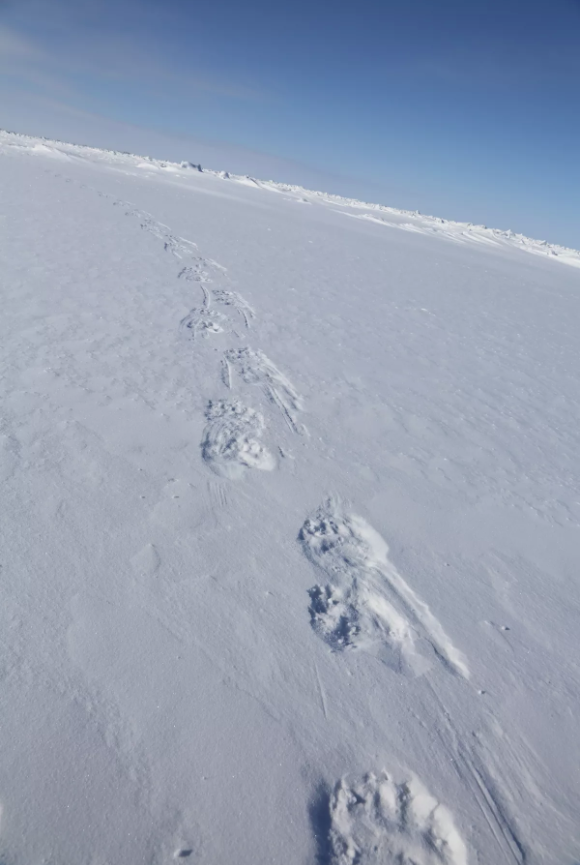SPOKANE — When Andrew Von Duyke, a wildlife biologist stationed in Fairbanks, Alaska, reached out to Jennifer Adams, a research scientist at the University of Idaho, for help with a research project involving polar bears, her answer was yes. Von Duyke was working to come up with a methodology to identify polar bears using the DNA left in snowy bear tracks. That was in November 2020.
By the same time the next year, the research team, which also included Justin Crawford and Lori Quakenbush of the Alaska Department of Fish and Game in Fairbanks, was ultimately successful.
“We documented our first successful results of sex and individual ID in November of 2021,” Adams said in an email. “To our knowledge, this is the first time that polar bears, or any other species, have been individually identified and sexed using environmental DNA collected from snow.”
Why reach out to Idaho scientists for research on Alaskan polar bears?
“Our laboratory here at the University of Idaho specializes in wildlife genetics, and in particular, in getting DNA from things that animals leave behind in the environment,” said Lisette Waits, Adam’s colleague and a professor of wildlife science at UI. “We’ve developed a reputation for being able to get DNA out of things that other people can’t.”
As participating scientists were separated by a sizable geographical gap, research took a lot of coordination. Collaborators in the indigenous town of Utqiagvik, previously known as Barrow, Alaska, collected polar bear DNA by scraping the outermost layer of snow from tracks. The snow would then be shipped to researchers with the Alaska Department of Fish and Game in Fairbanks. There, Crawford and Quakenbush would melt and filter the snow. Those filters, now containing polar bear cells, were then shipped to Moscow, Idaho, where Adams and Waits could then analyze the DNA.
In addition to leading DNA lab work at the university, Adams was able to be physically involved in collecting snow samples in Alaska.
For a week in April of this year, Adams stayed at a research facility outside of Utqiagvik, which is the northernmost town in the United States. She had to bundle up in three layers of clothing when she and her colleagues went out onto the sea ice on snowmobiles to collect snow from polar bear tracks.
“This is the furthest North I’ve ever been,” said Adams in an interview. “Being on the sea ice, that was beautiful and stunning and just an absolutely amazing experience.”
Polar bears have been classified as an endangered species by the United States since 2008.
According to the research group’s published work, “polar bears rely upon sea ice to hunt, travel, and reproduce.” Shrinking sea ice in the arctic means shrinking life-sustaining resources for the bears , which pushes the animals inland into human-populated areas.
Scientists monitor populations via DNA samples to provide vital information for polar bear conservation efforts.
“The genetic analysis that we do and that we’ve introduced in this paper can help answer all of those questions about where are the animals, how many are present in a population, and how genetically healthy are they in terms of levels of genetic variation and movement of individuals,” Waits said. “All of those pieces of information are super important when developing a conservation and management plan.”
This pilot technique comes in response to a slew of roadblocks researchers have been faced with in monitoring the polar bear population.
“Traditional methods for monitoring polar bears involve flying around in a helicopter, looking for polar bears, darting them to put them to sleep, so that people can handle the bears, take a genetic sample, (and) put a radio collar on them,” Waits said.
The helicopter method of gathering information on polar bears requires sea ice.
Not only is this method time-consuming and expensive, “climate change is leading to less sea ice, and so that’s also, for polar bears, making the traditional methods much harder to apply,” Waits said.
Traditional methods of obtaining DNA have also drawn concern from indigenous communities in Alaska, who traditionally hunt the species for subsistence, and who respect and honor the polar bears.
“For a lot of indigenous peoples, they find those methods of interacting with animals disrespectful, and they don’t really support that type of work,” Waits said.
As their published research explained, “ ‘No-fly zones’ around subsistence communities on Alaska’s coasts have been established as part of conflict avoidance agreements to reduce noise disturbance in hunting areas. Such restrictions often exclude helicopters from accessing areas where animals — including polar bears — congregate.”
There are other ways scientists can obtain DNA samples. Researchers can lure bears in with muktuk, a traditional indigenous food of whale blubber and skin, so that they can retrieve a sample of hair or saliva.
Additionally, “there are researchers in Canada who are studying polar bears using genetic techniques, and they’ve been using fecal samples as well as tissue from harvested polar bears,” Waits said.
Still, none of these techniques are perfect, and none are efficient enough to be the sole source of genetic information.
“This methodology is always going to be used in combination with other methodologies,” Adams said. “It’s all about finding a sort of sweet spot, where the most data is obtained with the least amount of risk to both the bears and biologists.”



